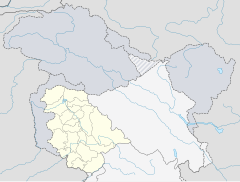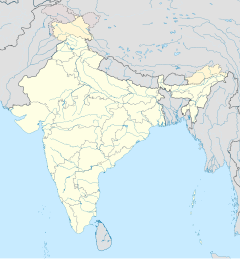Shankaracharya Temple
| Shankaracharya Temple | |
|---|---|

Shankaracharya temple
|
|
|
Location in Jammu and Kashmir
Location in Jammu and Kashmir
|
|
| Name | |
| Other names | Jyesteshwara temple, Pas-Pahar |
| Devanagari | शंकराचार्य मंदिर |
| Geography | |
| Coordinates | 34°4′44″N 74°50′37″E / 34.07889°N 74.84361°ECoordinates: 34°4′44″N 74°50′37″E / 34.07889°N 74.84361°E |
| Country | India |
| State | Jammu and Kashmir |
| District | Srinagar |
| Location | Srinagar |
| Elevation | 1,852.16 m (6,077 ft) |
| Culture | |
| Primary deity | Shiva |
| Architecture | |
| Number of temples | 1 |
The Shankaracharya Temple (Kashmiri: शंकराचार्य मंदिर (Devanagari), شنکراچاریہ مندر (Nastaleeq)), also known as the Jyesteshwara temple or Pas-Pahar by Buddhists. Shankracharya Temple, it was renamed as Takht-e-Suleiman, is situated on the top of the Shankaracharya Hill, also called Gopadari Hill. in the Zabarwan Mountain in Srinagar, Kashmir. It is dedicated to Lord Shiva. The temple is on the summit of the same name at a height of 1,000 feet (300 m) above the plain and overlooks the city of Srinagar.
The temple dates back to 200 BC, although the present structure probably dates back to the 9th century AD. It was visited by Adi Shankara and has ever since been associated with him; this is how the temple got the name Shankaracharya. It is also regarded as sacred by Buddhists. The Shiv ling was placed inside during the Sikh period in nineteenth century and it became an active Hindu temple when regular services were conducted. Some historians report that the temple was actually a buddhist temple during buddhist era which was then changed into Hindu site of worship by Adi Shankaracharya. Persians and Jews call it Bagh-i- sulaiman or the Garden of King Solomon. Persian inscriptions are also found inside the temple.
According to Pandit Anand Koul (1924) the temple was originally built by the Hindu king "Sandiman" who, according to Koul, reigned in Kashmir from 2629 to 2564 BC. It was repaired by King Gopaditya (426–365 BC) and by King Lalitaditya (697–734 A.D.). Sikandar, the Iconoclast did not, for some reason, destroy it. Zain-ul-Abidin repaired its roof which had tumbled down by earthquake. Sheikh Ghulam Mohi-ud-din, a Sikh Governor (1841–46), also repaired its dome. It was repaired by King Gopaditya (426–365 BC) and by King Lalitaditya (697–734). The earliest historical reference to the hill comes from Kalhana. He called the mountain Gopadri. Kalhana also says that King Gopaditya granted the land at the foot of the hill to the Brahmins that had come from the “Araya versh.” The land grant was called “GOPA AGRAHARAS”. This area is now called Gupkar. Kalhana also mentions another village in the vicinity of the hill. It so happens that the King Gopaditya housed some of the Brahmins who had eaten Garlic to a village next door. Kalhana names this village as Bhuksiravatika. That would be Buch’vore today. Kalhana also mentions that King Gopaditya built the temple on the top of the hill as a shrine to Jyesthesvara (Shiva Jyestharuda) around 371 BC. Abul Fazal also mentions that King Gopaditya built the temple. Although many experts believe that the current temple was probably built later but most of them agree that the base of the structure does seem to be very old. It is said that Lalitaditya Muktapida (724-726 AD) of Karakote dynasty did repairs to the temple. According to Srivara Budsah (Zain-ul-Abideen 1420-1470 AD) did major repairs to the temple. He also put the Kalash (spire) and the roof of the structure which had fallen due to an earthquake.The third time the temple was repaired was by the Muslim Governor, Sheikh Mohi-ud-Din (1842 to 1845) during the Sikh rule of Kashmir. some call it Takhti Suleiman also. Probably Jews believe the lost tribe of Israel lived in Kashmir. They refer to the culture and design of temple as the evidence. There is no doubt that there are lot of similarities between Israelites and Kashmiris.
...
Wikipedia


